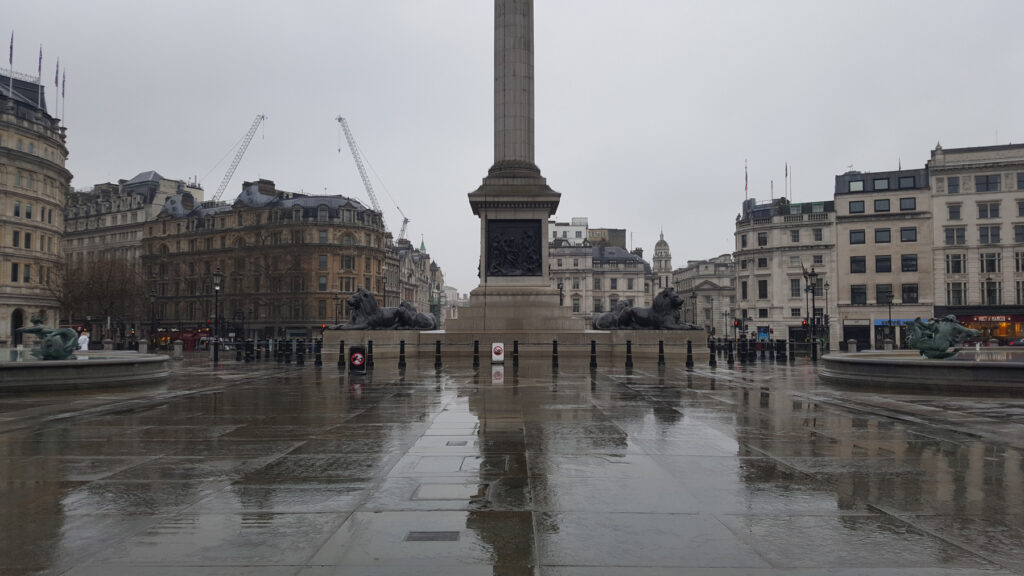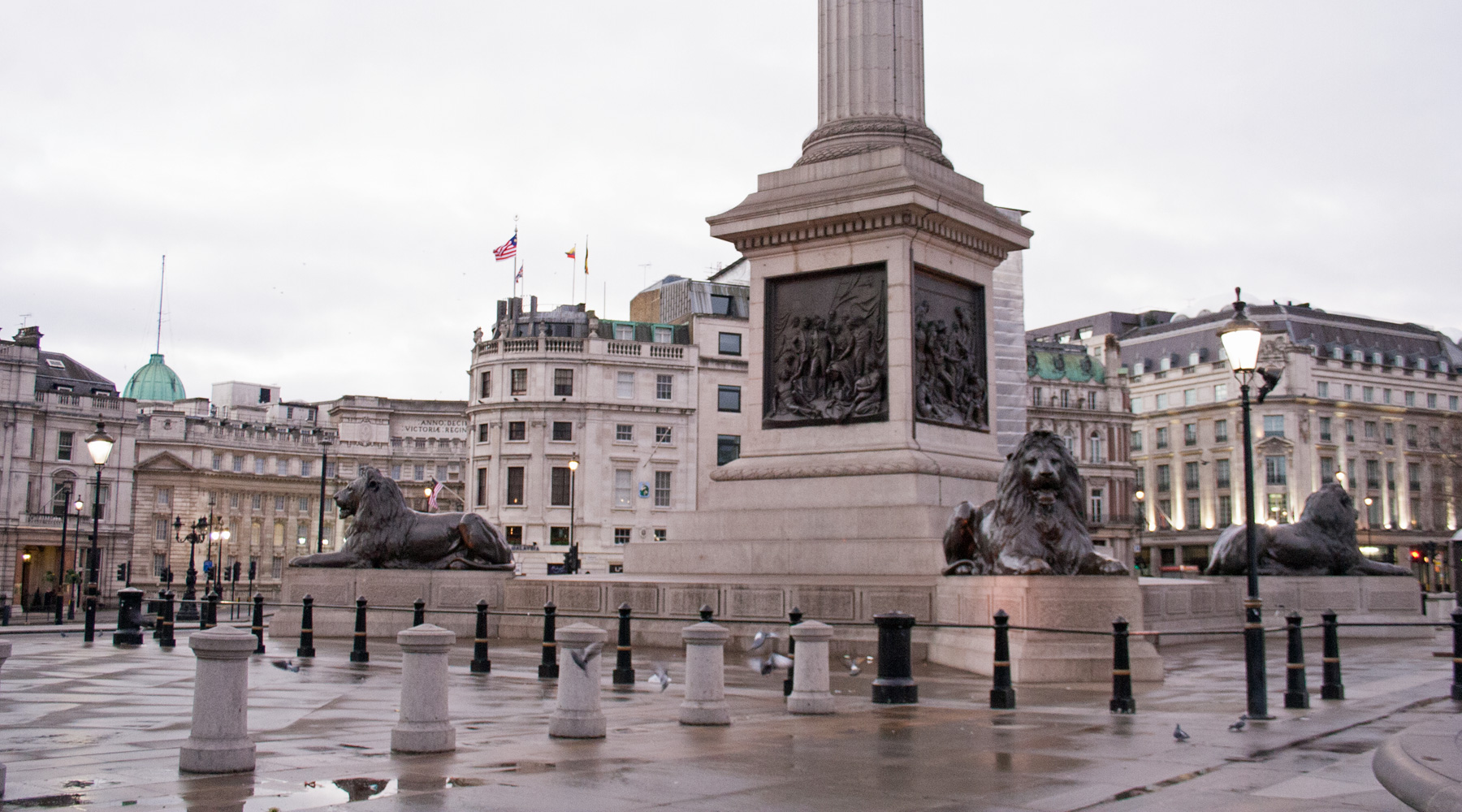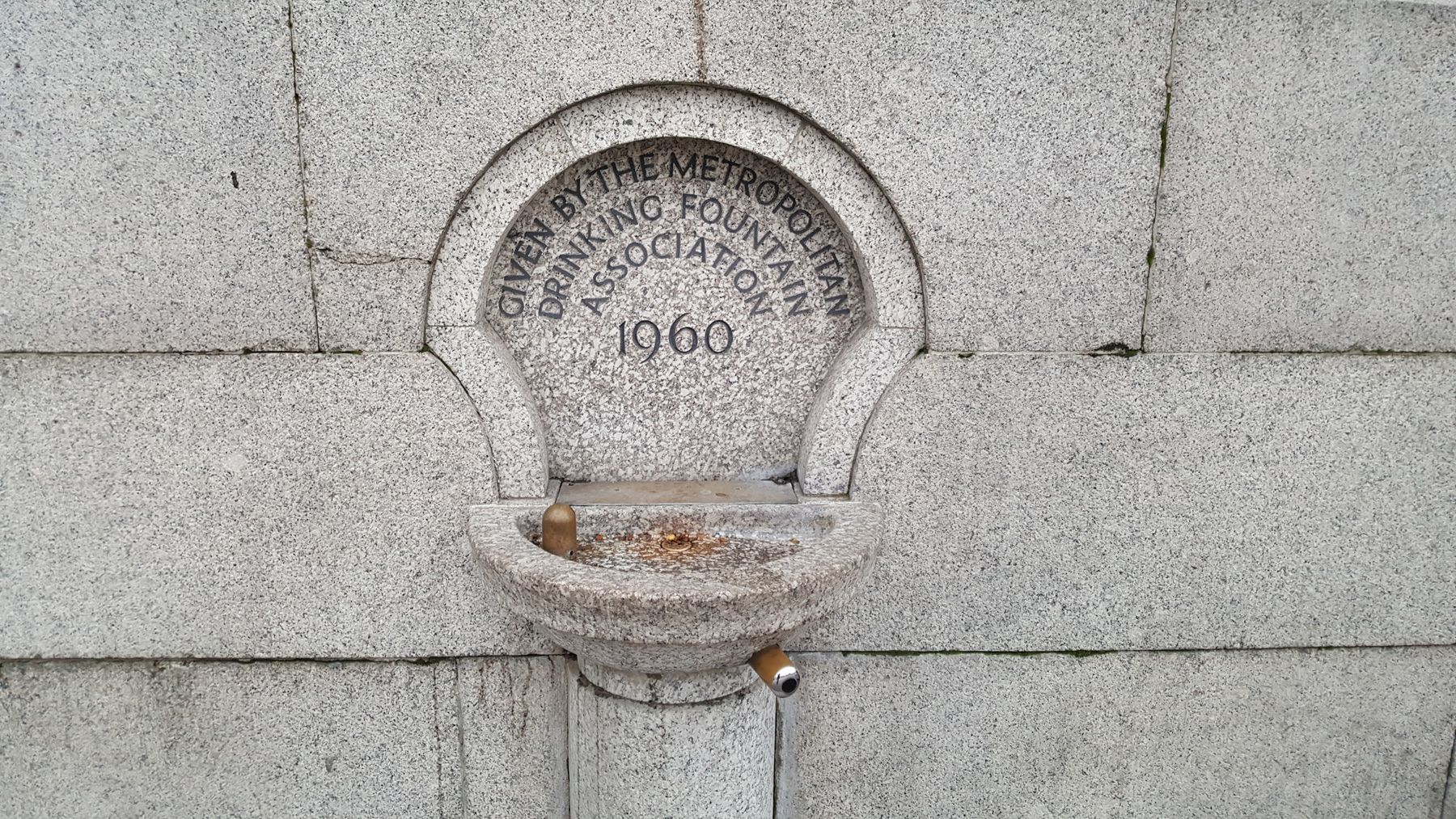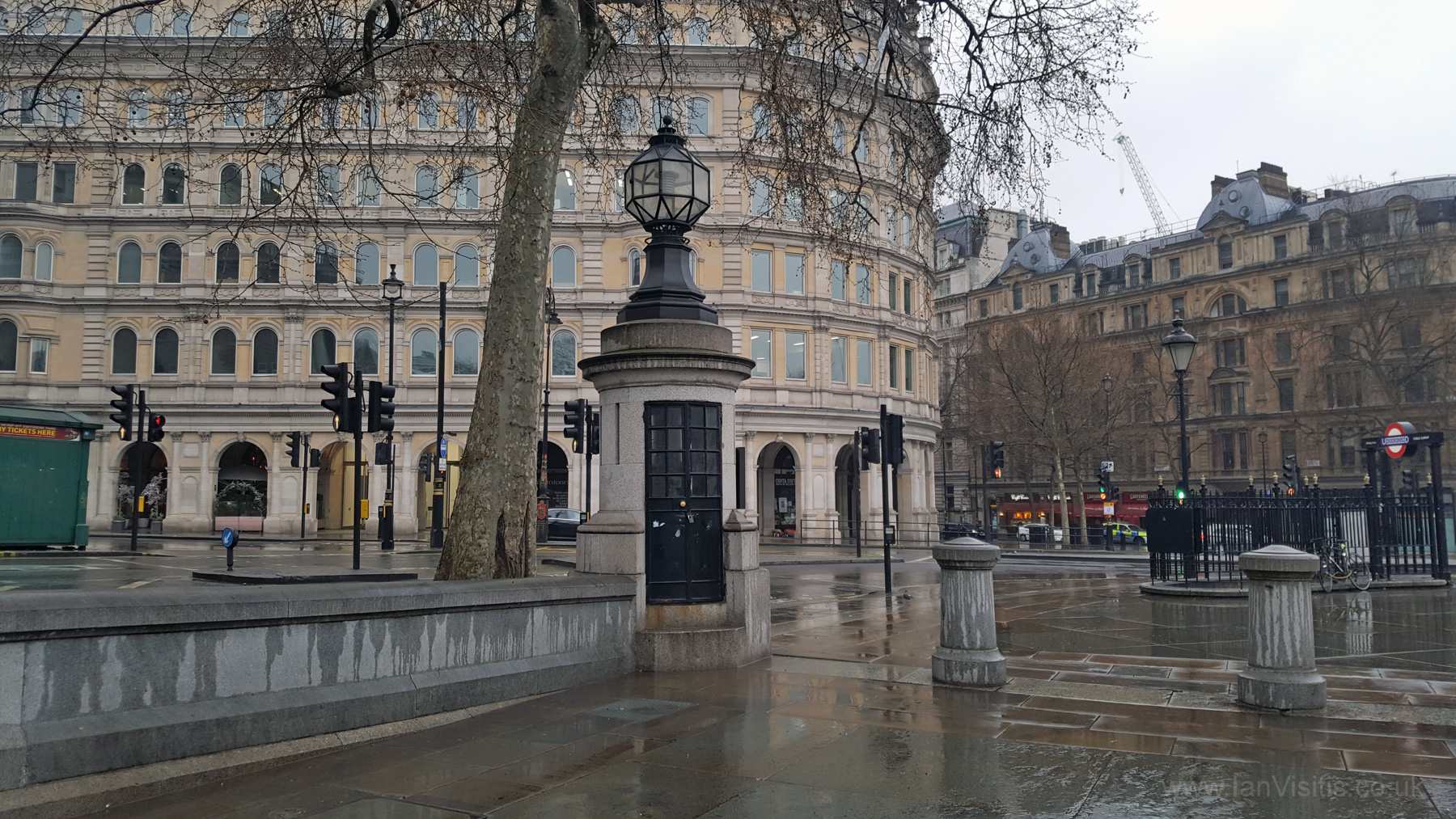Trafalgar Square – the history, the hidden tunnels, the statues, the lions, the column, the so-called police station, the imperial measures, and even some woolly mammoths.
1] What is Trafalgar Square?
A large public square in central London, formerly home to lots of pigeons and today often used for public events.
2] Who owns Trafalgar Square?
The Monarch owns Trafalgar Square.
The land Trafalgar Square occupies used to be the King’s horse stables and mews, and later the area was mostly fairly run-down properties. When the area was cleared of buildings in the early 19th century and the square laid out by Sir Charles Barry, it was decided to vest ownership of the square in The Crown, while the cost of managing it would fall to the Commissioners of Woods (later the Board of Works).
When the post of Mayor of London was created in 2000, the Greater London Authority Bill included a clause that the functions of the Secretary of State under section 2 of the Trafalgar Square Act 1844 (care, control, management and regulation of the Square and its ornaments etc) were transferred to the Mayor of London.
This creates an oddity. Trafalgar Square sits within the City of Westminster, so you’d think they would be looking after it. But in fact, it’s the Mayor of London who’s in charge, so Trafalgar Square is a little political enclave of Mayoral power within Westminster.
3] Why Trafalgar?
It wasn’t a square that was built to commemorate a battle, but an open space with no name that later acquired one.
The space for the Square was cleared soon after the passing of the Charing Cross Act which permitted it to be built, but it was probably going to be named after William IV commemorating his ascent to the throne in 1830, the year the clearance was started.
On the 8th October 1832, in a court circular, it was announced that “His Majesty has signified his desire that the new square at Charing-cross shall be designated after this great naval victory, which has hitherto been passed over in the choice of names for public places.”
It seems to have been adopted as the new name very quickly, with contemporary news reports about events in the area calling it Trafalgar Square within a couple of weeks, even as the site was still being cleared of old buildings in preparation for building work to start.
Trafalgar Square was finally opened to the public on 1st May 1844.
4] Why here?
Not one of mankind’s better decisions as it happens — it’s here to keep the poor away from the nice folk. Yes, really.
Not today of course, but when the architect John Nash was thinking up plans for Regent Street and a grand European style rebuilding of central London, part of the intent was to sweep away the slums and squalor of central London.
The new roads were deliberately designed to create a barrier between gentlemen and the working classes. In Trafalgar Square, the placement of the large fountains and the central Nelson’s Column was also deliberate — to make the gathering of large political protests so close to Parliament rather difficult.
As it’s now used for (mostly) peaceful protests and public events, that’s a desire that probably rankles with event organisers every day.
5] Nelson’s Column
The towering centrepiece of Trafalgar Square, it stands 169 ft 3 in (51.6 m) tall, with the much larger than life, 18ft 1in (5.5 m) statue of Admiral Nelson at the top.
Charles Barry, who designed the National Gallery and took over the layout of Trafalgar Square after Nash died, didn’t want Nelson’s Column to be here at all. He worried that it would distract attention from his Gallery building. Unfortunately for him, he took over after the foundations had already been laid, so he was stuck with it.
Construction started in July 1840, and the main tower was completed by the end of 1843. Nelson’s Column cost £47,000 to built in the 1840s, which is the equivalent of between £3 million and £4 million today. However, the public donations needed to build the tower ran out at the £25,000 mark, so the government took over the funding, and completion of Nelson’s Column.
The column is built in the Corinthian order, a style of ancient Greek and Roman architecture. It is characterised by slender fluted columns and elaborate capitals, which are decorated with acanthus leaves and scrolls.
The column is constructed out of Dartmoor granite and weighs around 2,500 tonnes. It was originally meant to be built entirely out of sandstone, but the plan was changed shortly before construction started.
The bronze reliefs on the pedestal each depict a scene from Nelson’s most famous battles: the Battle of the Nile, the Battle of Copenhagen, the Battle of Cape St Vincent and his death at the Battle of Trafalgar. They were not installed until 1849, and the metal came from French guns which had been captured and melted down.
When the column was measured in 2006, during renovation works, it was discovered that the monument is 14 ft 6 in (4.4 m) shorter than had always been thought. The actual height of Nelson’s Column, from the bottom of the pedestal to the top of Nelson’s hat, is 169 ft 3 in (51.6 m).
However, it was nearly much taller, as the original proposal was for a 203 ft (62 m) column, however, construction plans were scaled back due to concerns over stability and cost.
6] The Trafalgar Square Lions
There are four lions at the base of Nelson’s Column, and if you look carefully you’ll notice that while they look identical, there are subtle differences between all of them.
Designed by the painter Sir Edwin Landseer based on an actual, if a very dead lion, and cast by Baron Marochetti at his studio in Kensington, they were unveiled in 1867, a full decade after they were commissioned.
The lions are also not the ones originally planned. The commission to design them went to another artist, Thomas Milnes, but his designs were felt to be unfitting for the site, so Landseer was given the second commission to redo the work.
It’s said that the paws of each lion are not as graceful as the rest of the body as they were done last, and by which time the dead lion provided by London Zoo for the model had deteriorated rather badly.
None of the lions are individually named, but collectively they are often called the Landseer Lions.
Legend has it that the lions will come to life if Big Ben chimes 13 times.
Although cast in bronze, the original plans had called for stone or granite. Today it would be almost impossible to imagine anything but these magnificent 20 feet long bronze statues at the base of Nelson’s Column.
7] The Fountains (and a tunnel)
The fountains were installed after the Square was originally laid out, for two very different reasons.
In part, it was to reduce the effects of reflected heat from the large expanse of paved surface, but the government was rather keen on reducing the space available for protests to gather in the Square.
The fountain centrepieces are not the originals though. The originals were removed in the late 1930s, and ended up in Ottawa, Canada. The current fountain centres were designed by Sir Edwin Lutyens, and are actually memorials to Lord Jellicoe and Lord Beatty.
Originally the fountains were fed by a couple of wells underneath Trafalgar Square, but these were replaced by modern pumps, and a more recent upgrade can send a jet of water 24 metres into the sky.
8] Trafalgar Square’s Drinking Fountains
While you would not be recommended to drink from the decorative fountains, there was were two potable water drinking fountains installed by the Metropolitan Drinking Fountain Association, a charity in 1960, to mark the Association’s 100th anniversary.
Although they fell out of use for many years, they were restored back to working order in 2009, but seem to be broken again in 2018.
9] Trafalgar Square’s Police Station
A lamppost in the south-east corner of Trafalgar Square has an unusual claim to fame — it’s a police observation post, although may other people claim, erroneously, that it’s a police station.
It wasn’t there in the original plans, but as Trafalgar Square became a meeting point for political protests in subsequent years, it was decided that a police presence was needed in the Square to keep an eye on things.
Just before WW1, a temporary police hut was installed in the Square itself, but it was the General Strike of 1926 and the agitation of strikers protesting in the Square that encouraged the police to see a permanent station in the square. This hollowed out lamppost is the result, but not after a very long process.
For the full details, and correcting some urban myths here.
10] Standard Imperial Measures
In the wall and steps along the north side of Trafalgar Square are a series of plaques, each representing an official measurement of distance.
They were installed by the Board of Trade in 1876 after previous official measurements were destroyed when Parliament burnt down in 1834.
Governments have long had official measures, to ensure that goods sold as weighing a certain amount, or cloth cut to a certain length actually matches what you would get if the same measurement was used elsewhere.
Today highly sophisticated measures are used, but back in Victorian times, these bronze plaques were considered so accurate that they were placed in public venues for anyone to come over and compare their own ruler against the official standard.
The standard shown here were created by a Standards Commission, chaired by the Astronomer Royal, Sir George Airy who issued the new official measurements in a series of announcements between 1838 and 1842.
The plaques were not installed in Trafalgar Square until 1876, and some on the upper level were moved into the Square in 2003 when the upper level was pedestrianised.
Starting on the eastern side, with the official plaque, what you’ll find are bronze markers in the pavement for progressively larger distances.
A whole range of old Imperial measures are here, such as the Perch (for farming), the Link (for surveying) and the Chain (for railways, and cricket pitches).
The standards plaques can also be found in the City of London Guildhall and at the Royal Observatory Greenwich – as insurance that a fire wouldn’t destroy the only copy again.
11] The Plinths
There are four large plinths in Trafalgar Square, of which three are occupied by the sorts of generic military statues you expect to find in such a place, and one has modern art.
There were originally intended to be four statues, and the arty plinth should have an equestrian statue of King William IV, as a counterpoint to the statue of King George IV, but a lack of funds at the time meant it wasn’t added, and the plinth remained empty right up to 1998 when it was used as a temporary location for art.
As these seemed to be rather popular, the government commissioned a study as to what to do with the empty plinth, and ever since, it’s been used for a series of modern art commissions by the Mayor of London’s office.
The other three plinths are of George IV, by Sir Francis Chantrey, which was originally intended to be placed on top of Marble Arch but ended up here instead. Then there’s General Sir Charles James Napier in the south-west corner and Major-General Sir Henry Havelock in the south-east.
There are also three busts along the north side of Trafalgar Square, of Lord Jellicoe, Lord Beatty, and First Sea Lord Admiral Cunningham. There’s a large, often ignored stone plaque in the floor of Trafalgar Square between the two fountains that explains why the busts are here.
12] Statues that used to be in Trafalgar Square
Despite the long empty plinth waiting for a statue, it’s not as if there was a lack of them. Originally, Trafalgar Square had two more statues that have since been removed.
When it was opened, in the centre between the two fountains stood a statue of General Charles Gordon.
His statue was removed in 1943, and despite an appeal from Winston Churchill for its restoration, it was re-erected outside the MoD buildings on Whitehall in 1953.
Another former statue that was later moved is one of the vaccine scientist, Edward Jenner. His seated statue was originally unveiled by Albert, Prince Consort in Trafalgar Square on 17 May 1858.
However the decision to honour a civilian in a Square that was traditionally for military heroes was controversial, and after Prince Albert died, there was growing pressure for its removal.
The statue was moved in 1862, and the British Medical Journal commented on the decision, noting that the military statues to Jenner, and noted that they remained in Trafalgar Square “because they killed their fellow-creatures whereas he only saved them”
The statue is currently in Kensington Gardens.
13] Trafalgar Square during World War II
Although Trafalgar Square was never hit by bombs during WW2, the roads around it were, so it was a very close-run thing. One bomb, to the south, came very close to Nelson’s Column, which would have been a significant propaganda victory had the bomb been just a few metres closer.
The Square was however used on several occasions to show off Allied weapons to the public and to raise funds for the war effort.
And of course, it was one of the major sites for the VE Day celebrations.
14] The abandoned tube tunnels
When the Jubilee line was being dug in the early 1970s, they needed some access tunnels to get to the building site underneath Charing Cross tube station.
The tunnel runs from Charing Cross station — where the Jubilee line used to terminate — to just by where the Sainsbury Wing of the National Gallery is now located. It then ran up to the surface for the construction access and was used mainly to remove waste from the tube tunnel works.
Although the shaft to the surface was long since been filled in, the tunnels themselves remain there, mainly as they are convenient storage space for the London Underground.
There are also occasionally opened to the public for tours.
15] The Trafalgar Square Pyramid
200 years ago, a plan was announced to erect a giant pyramid in the centre of London, for no purpose other than to cock a snoot at the French. The idea for the pyramid came from Sir Frederick William Trench, an MP and soldier who wanted to commemorate the defeat of the French at the Battle of Trafalgar which had taken place just 10 years earlier.
However, the monument wasn’t to commemorate the Battle of Trafalgar, but the war entire, and specifically, the Battle of the Nile, which the MP saw as the real turning point in Napoleon’s imperial ambitions.
And that was the reason for a pyramid.
According to a letter from the architects to Lord Anglesey, the pyramid would have been taller than St Paul’s Cathedral and had a base of around 360 feet along each side.
More about that crazy scheme here.
16] Elephants and Hippos
Building work in the 1950s on the south side of Trafalgar Square uncovered deposits left over from the last interglacial period when England was a much warmer country. Among the findings were the remains of cave lion, rhinoceros, straight-tusked elephant and hippopotamus.
So yes, at one point, hippos and elephants roamed over Trafalgar Square.
Some of the bones are now on display in the Natural History Museum.
17] Monopoly board game
As a famous place, it’s no surprise that Trafalgar Square appears as a landing spot in the game of Monopoly.
That’s actually a bit awkward, as you can’t buy a property on Trafalgar Square itself, although if fantastically rich you might be able to persuade an owner of the buildings next to it to sell up. The reason these locations are used has been lost to the mists of time, but the most common reason given is that the three streets in the pink zone, Pall Mall, Whitehall, and Northumberland Avenue all converge on Trafalgar Square.
Back in 2016, the location was chosen for a giant game of Monopoly for the London Games Festival.
18] The Pigeons
For many years, Trafalgar Square was as famous for its pigeons as its monuments, and there were pigeon seed sellers who catered to the tourists for whom a photo of themselves being surrounded by flying rats was a curious highlight.
Ken Livingston, the first Mayor of London banned feeding pigeons in the Square in 2000. The thousands of pigeons that flocked to the Square were a health hazard and their droppings also damaged the monuments. The sale of birdseed was banned in 2001, followed by laws forbidding feeding pigeons by members of the public in 2003.
There is still an organisation campaigning to allow the feeding of pigeons again, but as the public tends to look at pigeons as a nuisance than a delight, their support has faded into obscurity.
19] The Christmas Tree
Christmas trees had been in Trafalgar Square for many years before the current tradition started. However, in 1947, the city of Oslo in Norway gifted a tree to the people of Britain. This was in recognition of British support to Norway in WWII, and the tree is now an annual tradition. It’s decorated Norwegian style with long strings of lights and is switched on from the first Thursday in December. The tree itself is typically a 50-60-year-old Norway Spruce that is chopped down in November in a ceremony that is attended by the Mayor of Oslo and the Lord Mayor of Westminster.
The tree is a gift from the government of Norway, but there is a charge for delivering it from Felixstowe to London – of just £1.
After Christmas, the tree is removed and recycled into mulch for composting.
Fin
And that’s (probably) everything you always wanted to know about Trafalgar Square (but were afraid to ask).



















So if Big Ben strikes 13 times the lions will come to life … Best hope they don’t adopt the 24 hour clock as 1pm will become feeding time ….
You missed out important moment when Dr Who’s Tardis visited the square with Matt Smith being lifted away by UNIT helicopter .
It’s a wonder how that Police Station has not appeared in a Bond movie given how close it is to Whitehall.
As for the Square separation of wealthy from the poor it’s worth remembering that Seven Dials in Covent Garden which was a slum haunt for the likes of Fagin is not very far from Trafalgar Square!
Nice post – really enjoyed reading that. Thanks!
Thank you for putting together all this information. But an important piece is missing though: the equestrian statue of Charles I and the famous plaque behind it marking ‘point 0’ from which distances from London are measured!
I omitted it because the statue is not in Trafalagar Square.
What about the statue of the Boer War soldier (or some such campaign) that was moved?
What are the buildings that are there in the ww2 photo? An air raid shelter!
My parents took a curious photo of me aged 2 years surrounded by flying rats
For me, this place is the symbol of christmas.
When I was a child, this was the only public place with a christmas tree, about I heard at those time. I love London, even if I am not even british.
Thanks for the informative site. I originally looked it up to find out why the fountains are a shadow of their former glory – even in times of water plenty. Though you say the pumps ‘can send a jet of water 24metres into the air’ I haven’t seen them do more than probably 10 feet – if that – for ages. Is this a saving on power or water or something? (presumably the water is recycled in a closed system?) The Italians enjoy their grand fountains – we seem to prefer an economical trickle – very British.
The joke was that there was a sign on the false kiosk during WW2 saying “closed Monday to Friday, not open weekends “
Is it true or an urban legend that the lions body are in fact dogs, because the scupture had never seen a lion before. The guide told us that lions cannot sit in that position. But it must be an urban legend because I did not read it anywhere
I have definitely heard tourist guides saying this whilst leading tourists around the square but – like you – I cannot find anything to back this up. It is true, however, that the paws are actually cats paws rather than lions.
how accurate is the LeGO set of trafalgar square?
Is it a fact the lions were cast from the metal from captured French and Spanish cannons in the Battle of Trafalgar?
I just read this wonderful article. I am a born and bred Londoner but much of the information was unkwown by me. Thank you for writing it!